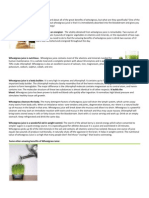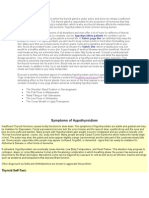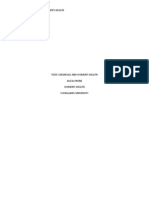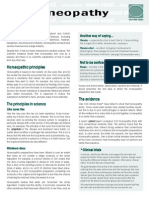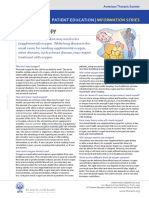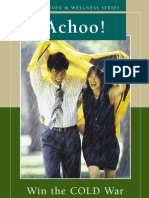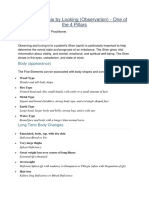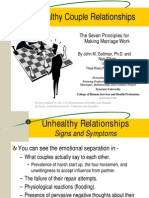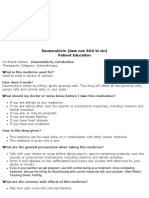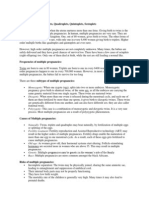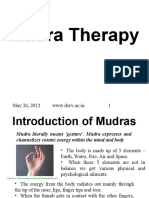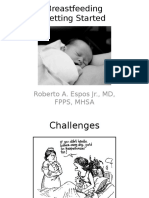Cold and Flu Relief
Cold and Flu Relief
Uploaded by
TheVitaminStore.comCopyright:
Available Formats
Cold and Flu Relief
Cold and Flu Relief
Uploaded by
TheVitaminStore.comCopyright
Available Formats
Share this document
Did you find this document useful?
Is this content inappropriate?
Copyright:
Available Formats
Cold and Flu Relief
Cold and Flu Relief
Uploaded by
TheVitaminStore.comCopyright:
Available Formats
cold & flu
Cold and Flu Relief
Did you know that over 200 viruses are known
to cause what we call The Common Cold?
They can survive on doorknobs, telephones,
computers, tabletops, and even your skin for
as long as 3 hours. Experts report that children
can have between 6 and 12 colds a year. Adults
average 2 to 4 colds per year, with women having greater numbers of colds than men, perhaps
because of increased contact with children.
Conventional therapies for cold and flu focus
primarily on temporary symptom relief.
However, in this Terry Talks Nutrition,
I recommend three herbal ingredients that
enhance the bodys ability to fight off a cold or
flu and stop it in its tracks.
Why Treat a Cold? Is It Really
THAT Serious?
While a cold may not be very dangerous on its
own, it can lead to conditions that can be lifethreatening: bacterial infections like pneumonia
and bronchitis.
When you are infected with a cold virus, it can
cause more fluid than usual to accumulate in
our sinuses and lungs hence the runny noses,
sneezes, and coughs. These warm, dark, wet
places are a perfect breeding ground for bacteria
that cause lung and sinus infections. Also, since
the immune system is busy battling the cold
virus, it may run out of steam when the bacterial
invaders come along. These bacterial invasions
are called secondary infections because they
follow in the wake of the common cold.
And with everything you may have heard in
the news, I probably dont have to tell you that
flu (influenza) viruses can be anywhere from
mild to life-threatening. Their survival outside
the body is better, too, as some strains can
live for 24 hours on hard surfaces and up to 12
hours on soft.
So it is extremely important to focus on
prevention, especially during cold and flu
season. And anything that can shorten the
duration and reduce the severity can be
tremendously important, since there are no
medical cures for either the common cold or
influenza. Since symptoms vary greatly and
are of different levels of concern based on your
health history, I would highly recommend that
you consult your physician as to the best way
to treat any illness at the onset.
Personally, I prefer not to subject myself to a flu
shot or take medication that can also cause side
effects. I want my body and immune system
to adjust to the virus and, in turn, become
stronger for the next onslaught of the cold and
flu season. I have a concern that reliance on flu
shots and medications are keeping our immune
systems from the natural strengthening that
occurs with exposure. I wonder if this missed
opportunity to strengthen our immune response
leaves us ill-prepared to react to other viruses
and bacteria. Fortunately, there is a better way.
Powerful Cold-Stopping Trio:
The first herb I recommend in this combination is the root of Pelargonium sidoides
(Umckaloabo). This herb traditionally was used
by the South African Zulus for hundreds of
years to treat coughs, colds, upper respiratory
tract irritations, tuberculosis and gastrointestinal complaints. It is still a natural medicine
prescribed by traditional healers in South Africa.
According to the book Tradition, Culture and
Development in Africa by Ambe J. Njoh, an
Englishman named Charles Stevens traveled to
South Africa in 1897 in search of treatment for
tuberculosis. He encountered a doctor of traditional African medicine who prepared for him a
decoction of Pelargonium sidoides. He recovered
completely, and subsequently brought the plant
home with him to England, where he created a
medicine called Stevens Consumption Cure,
which became very popular.
In the early 1920s, a Swiss medical doctor,
Dr. Adrien Sechehaye, became interested in
this pelargonium decoction and brought it to
Switzerland, where he successfully treated over
800 patients with tuberculosis, between 1920
and 1929. In 1929, he published a collection of
these medical case studies. With the advent
of synthetic drugs in the 1930s, interest in
botanical medicines began to decline, and
Pelargonium languished for fifty years until it
was revived by renewed European interest in
beneficial herbal remedies.
To your good health,
Terry... Naturally
Terrys Bottom Line:
When you need to stop a cold or
flu, you want more than relief you
want the illness to go away so you
can recover faster. The problem
with conventional medicines is that
they have questionable benefits,
many side effects, and may actually
weaken your immune systems ability
to fend off disease causing viruses
and bacteria.
There are powerful herbal ingredients
that are especially effective:
Stops colds and the flu from
taking hold
Destroys bacteria and viruses
Prevents dangerous secondary
infections
Shortens the duration of respiratory
infections
Safe and effective for adults and
children alike
Helps you feel better faster
without adverse side effects!
Here is the formula I suggest:
Proprietary Formula
226 mg
Echinacea (Echinacea purpurea) Cold
Pressed Juice Extract (45:1 ratio) standardized
to contain >2.4% -1,2-D-Fructofuranosides,
Andrographis (Andrographis paniculata)
Leaf Extract standardized to contain
> 30% andrographolides, Pelargonium
(Pelargonium sidoides radix) Root Extract
standardized for > 0.3% umckalin
More...
www.TerryTalksNutrition.com
12006_0313.TTN039
Cold and Flu Relief
In Germany, pelargonium has been
prescribed over-the-counter since 1983 and
German doctors have observed widespread
effectiveness against infections of the sinus,
throat and respiratory tract. Double-blind,
placebo-controlled studies on patients with
acute bronchitis confirmed that extracts of
Pelargonium sidoides are effective in treating
this ailment.
Children as young as six years of age have seen
excellent results from Pelargonium, especially
those who have not responded well to repeated
treatments with antibiotics. In a recent doubleblind, placebo-controlled study, 103 people
with the common cold were given either
Pelargonium sidoides or a placebo. After 5 days,
the reduction of symptoms was almost double
in the pelargonium group. After 10 days, 78.8%
of the pelargonium group was completely
cured, vs. only 31.4% of the placebo group.1
Pelargonium sidoides is considered to have
antibacterial, antiviral, and expectorant
properties. This triple action attacks the acute
infection at its root, and strengthens the
immune system, helping to prevent re-infection.
Due to its bacteria-killing and immune
modulating characteristics, pelargonium is
the perfect choice when treating the cold,
flu, and other respiratory illnesses, which are
astoundingly common each year.
In fact, Americans suffer over 500 million
colds every year, which costs about $40 billion
dollars annually. And medical treatment, which
accounts for 45% of the money spent, isnt even
half of the cost. About 55% is due to indirect
costs, such as missed work days. Aside from
that, another $3 billion dollars is spent every
year on over-the-counter (OTC) medications
that do little good and in some cases, much
harm. In Germany, where botanical medicine
is mainstream, pelargonium is immensely
popular, and typically outsells conventional OTC
drugs. It has been clinically studied and proven
to reduce the severity and shorten the duration
of colds and flu, without the side effects so
commonly experienced with drugs. I believe
that pelargonium root can have a huge impact
on keeping you healthy and your immune
system strong.
The second herb in this combination is a clinically
proven, standardized extract derived from the
plant Andrographis paniculata, commonly
known as the King of the bitters, and widely
used in Ayurvedic medicine. Andrographis
helps prevent the common cold, and reduces
the intensity of symptoms particularly
sore throat and runny nose. Two systematic
reviews of available clinical studies have further
highlighted these conclusions. Andrographis
has been shown to possess immune-stimulant
and anti-inflammatory activities in scientific
studies. In a double-blind, placebo-controlled
trial, this standardized andrographis extract I
recommend was administered to 223 adults
with uncomplicated upper respiratory tract
infections (URTI). There was a significant
decrease in the symptoms of URTI compared to
the placebo group. None of the studies indicate
any serious adverse side effects. In addition,
andrographis has a long traditional-use history,
with no safety issues reported.
The third herb I recommend in this combination
is Echinacea purpurea.
Echinacea has been well-known as an immuneboosting botanical for generations. Again and
again, studies find that this herbal extract
reduces the length and severity of colds, and
helps people get back on track much faster.
The compounds in Echinacea that are considered
most responsible for this are polysaccharides
and glycoproteins that stimulate the immune
system. This makes Echinacea especially useful
when taken at the very beginning of a cold
or flu, when the body needs to marshal its
strength against the virus.
In a recent randomized, double-blind, placebocontrolled clinical trial, an Echinacea extract
was tested over a 4-month period. Participants
recorded and rated cold-related issues in a
diary throughout the investigation period.2
Additionally, nasal secretions were sampled
at acute colds and screened for viruses. The
results were impressive: Echinacea not only
reduced the total number of cold episodes,
but also the cumulative total of cold episode
days within the treatment group, and the total
number of occasions of pain-killer use to relieve
other symptoms. It was shown to inhibit virally
confirmed colds and prevented viral infections.
Another recent review of complementary
treatments for colds and flus found that
Echinacea purpurea was consistently the most
effective choice. The researchers found that
symptom severity was reduced in 4 out of 6
trials, and that of the 4 trials that measured the
duration of cold symptoms, the reduction was
significant in some cases by 3 or 4 days!3
If I were to come down with a cold or flu, the
combination of pelargonium root, andrographis,
and echinacea would be my choice to relieve
symptoms and help me recover much faster. It
is my favorite combination to boost my immune
system and help assure a healthy upper respiratory tract. This triple action combination can
be used when you start to become ill, or it can
be used long term as a preventative, especially
during cold and flu season, to give your body
the extra immune strengthening it needs.
REFERENCES:
1. Lizogub VG, Riley DS, Heger M. Efficacy of a pelargonium sidoides
preparation in patients with the common cold: a randomized,
double blind, placebo-controlled clinical trial. Explore (NY). 2007
Nov-Dec;3(6):573-84.
2.
Jawad M, Schoop R, Suter A, Klein P, Eccles R. Safety and
Efficacy Profile of Echinacea purpurea to Prevent Common Cold
Episodes: A Randomized, Double-Blind, Placebo-Controlled Trial.
Evid Based Complement Alternat Med. 2012;2012:841315.
3. Nahas R, Balla A. Complementary and alternative medicine for
prevention and treatment of the common cold. Can Fam
Physician. 2011 Jan;57(1):31-6.
When in doubt, always consult your physician or
health care practitioner. This column is to provide
you with information to maintain your health.
Subscribe to a free weekly health newsletter at
www.TerryTalksNutrition.com
www.TerryTalksNutrition.com
2013
Pg. 2
You might also like
- Nutritional Medicine First Edition Alan Gaby Md All Chapters Instant DownloadDocument60 pagesNutritional Medicine First Edition Alan Gaby Md All Chapters Instant Downloadgeluzdereeao100% (3)
- Decision Making in Adult Neurology - 2020Document391 pagesDecision Making in Adult Neurology - 2020Ahmad mughal100% (1)
- CrackTheNac 8 Case For The NAC OSCEDocument19 pagesCrackTheNac 8 Case For The NAC OSCEEmad Mergan100% (6)
- EDITED ENDO50items 1Document12 pagesEDITED ENDO50items 1Darren Vargas100% (1)
- Benefits of Wheat Grass JuiceDocument5 pagesBenefits of Wheat Grass JuiceRonald J'sonNo ratings yet
- Case Study - Seizuring DogDocument8 pagesCase Study - Seizuring Dogapi-301746262No ratings yet
- Dialysis and DietDocument2 pagesDialysis and DietgregcolletteNo ratings yet
- Leaked Briefing Notes Obtained by Moms On The MoveDocument10 pagesLeaked Briefing Notes Obtained by Moms On The MoveSean HolmanNo ratings yet
- Vasculitis DietDocument9 pagesVasculitis DietHemNo ratings yet
- A Complete HandbookDocument11 pagesA Complete HandbookPinkyNo ratings yet
- SuperFood SuperYou by Dr. Josh Axe - Advanced Nutrition For Weight Loss Detoxing Anti-AgingDocument21 pagesSuperFood SuperYou by Dr. Josh Axe - Advanced Nutrition For Weight Loss Detoxing Anti-AgingSujatha VimalNo ratings yet
- Blood Thinning Foods To AvoidDocument2 pagesBlood Thinning Foods To Avoidjayjonbeach100% (1)
- 8 Foods That Boost ImmunityDocument3 pages8 Foods That Boost Immunityopenid_wLejBiseNo ratings yet
- Hypo Thy Rod IsmDocument17 pagesHypo Thy Rod IsmanusinghNo ratings yet
- Toxic Chemicals and WomenDocument6 pagesToxic Chemicals and WomenAlicia Krone100% (1)
- Protocols and Presentations On Nutritional Therapeutics - Orthomolecular, Online - . - and Free of ChargeDocument1 pageProtocols and Presentations On Nutritional Therapeutics - Orthomolecular, Online - . - and Free of ChargeYassine ZIDINo ratings yet
- Health Guide PDFDocument78 pagesHealth Guide PDFPriya SinghNo ratings yet
- That Guy Who Ate All The Potatoes CookbookDocument52 pagesThat Guy Who Ate All The Potatoes CookbookAstrid SabirinNo ratings yet
- Candida VulvovaginitisDocument20 pagesCandida VulvovaginitisVicobeingo100% (1)
- ARW Hexagon 100610Document52 pagesARW Hexagon 100610Violet Lee100% (1)
- Digestive Aid Cleanse InstructionsDocument8 pagesDigestive Aid Cleanse InstructionsjohnnemanicNo ratings yet
- Vitamins & MineralsDocument25 pagesVitamins & MineralsKirk Northcott100% (1)
- Nutrients Why - Benefits, Risk & Side Effects Side Effects (Overdose) How-Natural Source/ Supplements DosesDocument7 pagesNutrients Why - Benefits, Risk & Side Effects Side Effects (Overdose) How-Natural Source/ Supplements Dosesjohnsonkk125No ratings yet
- Health Seminar PresentationDocument46 pagesHealth Seminar Presentationmr_harshahsNo ratings yet
- Handling Rheumatoid ArthritisDocument8 pagesHandling Rheumatoid ArthritisDisha TNo ratings yet
- Mcs Under SiegeDocument16 pagesMcs Under Siegeapi-269724919No ratings yet
- AaTen Products You Should Ban From Your Home ForeverDocument9 pagesAaTen Products You Should Ban From Your Home ForeverSahil NaikNo ratings yet
- Arthritis Means Joint InflammationDocument9 pagesArthritis Means Joint InflammationPrity DeviNo ratings yet
- Lymphatic Rescue Summit 2022 Day 6Document4 pagesLymphatic Rescue Summit 2022 Day 6Paul Ioan Popescu100% (1)
- Cococin - Tropic ThunderDocument3 pagesCococin - Tropic ThunderKirtika Vaish100% (1)
- The Probiotic Cure EHCDocument32 pagesThe Probiotic Cure EHCGrosu Iulian Alexandru100% (2)
- Depression Solutions Transcript 07 30 19Document28 pagesDepression Solutions Transcript 07 30 19Claudia TessarinNo ratings yet
- Turpentine ProtocolDocument6 pagesTurpentine ProtocolScribdTranslationsNo ratings yet
- Gas Problem in StomachDocument2 pagesGas Problem in Stomachyash_btech100% (1)
- Homeopathy For Self Transcendence Sports and UltrarunningDocument17 pagesHomeopathy For Self Transcendence Sports and UltrarunningRenoir FontesNo ratings yet
- Ala+ Dmsa: 4 Days After Last Exposure 4 Hours of More Frequently 1 Hour MaximumDocument4 pagesAla+ Dmsa: 4 Days After Last Exposure 4 Hours of More Frequently 1 Hour MaximumkishzNo ratings yet
- Do Vitamins C and E Affect Respiratory InfectionsDocument143 pagesDo Vitamins C and E Affect Respiratory Infectionspetri_jvNo ratings yet
- Alcoholism Diet Obesity Diabetes: Fatty LiverDocument5 pagesAlcoholism Diet Obesity Diabetes: Fatty LiverMukul NehwalNo ratings yet
- Reasons Vitamin D Is Critical To HealthDocument11 pagesReasons Vitamin D Is Critical To Health3 RIVERS PHARMACY100% (1)
- Wheat Grass Juice Is Natural Life Saver - Health TipsDocument7 pagesWheat Grass Juice Is Natural Life Saver - Health TipsHimanshu GuptaNo ratings yet
- Snow Mountain Garlic - AyuNatureDocument9 pagesSnow Mountain Garlic - AyuNatureAyuNatureNo ratings yet
- PeritonitisDocument4 pagesPeritonitislilaningNo ratings yet
- Impotence & Its Treatment - Bashir Mahmud ElliasDocument7 pagesImpotence & Its Treatment - Bashir Mahmud ElliasBashir Mahmud ElliasNo ratings yet
- Homeopathic Remedies For Kidney Stones - HompathDocument5 pagesHomeopathic Remedies For Kidney Stones - HompathBGNo ratings yet
- Blood From Shots To Clots NewDocument121 pagesBlood From Shots To Clots NewJoel S. HirschhornNo ratings yet
- Artrities CausesDocument5 pagesArtrities CausesivahdamNo ratings yet
- The Real Miracle NutrientDocument3 pagesThe Real Miracle Nutrientcharismasystemsltd100% (1)
- Immunity Booster Supplements To Fight Against Viral Infection With Prominence On COVID-19 An ReviewDocument9 pagesImmunity Booster Supplements To Fight Against Viral Infection With Prominence On COVID-19 An Reviewyogesh ushirNo ratings yet
- FluorideSpecialReport ToxicWatersDocument14 pagesFluorideSpecialReport ToxicWatersFisnik I. MahmutiNo ratings yet
- Vitamin D Intoxication and HomoeopathyDocument19 pagesVitamin D Intoxication and HomoeopathyDr. Rajneesh Kumar Sharma MD HomNo ratings yet
- 10 Steps To Reversing Rheumatoid Arthritis Inflammation and Other Autoimmune Diseases - The Hearty SoulDocument8 pages10 Steps To Reversing Rheumatoid Arthritis Inflammation and Other Autoimmune Diseases - The Hearty SoulOCanadianNo ratings yet
- Nutritional Psychiatry - Your Brain On Food - Harvard Health Blog - Harvard Health PublishingDocument9 pagesNutritional Psychiatry - Your Brain On Food - Harvard Health Blog - Harvard Health PublishingAna Rica Santiago Navarra-CruzNo ratings yet
- Parasite Herbal RemediesDocument10 pagesParasite Herbal Remediesdonaldbrown16No ratings yet
- 15 Health Benefits of GarlicDocument4 pages15 Health Benefits of GarlichiteshNo ratings yet
- Home Remedies For Gray HairDocument3 pagesHome Remedies For Gray Hairjerusalem nigussieNo ratings yet
- MAKE YOUR PRACTICE FLOURISH WITH FERTILITY NUTRITION - Workbook PDFDocument8 pagesMAKE YOUR PRACTICE FLOURISH WITH FERTILITY NUTRITION - Workbook PDFHershey AngelesNo ratings yet
- Homeopathy PDFDocument2 pagesHomeopathy PDFphilip54850% (2)
- Prematures enDocument6 pagesPrematures enFaisal HanifNo ratings yet
- Oxygen Therapy PDFDocument2 pagesOxygen Therapy PDFFelicia Risca RyandiniNo ratings yet
- Homeopathy Remedies For All Disease.Document16 pagesHomeopathy Remedies For All Disease.Abdicated KingNo ratings yet
- Natural Remedies For Heart DiseaseDocument8 pagesNatural Remedies For Heart DiseaseNur HowladerNo ratings yet
- Regenerative Medicine: Platelet-Rich Plasma and Stem Cell-Rich Prolotherapy For The Treatment of Musculoskeletal PainDocument9 pagesRegenerative Medicine: Platelet-Rich Plasma and Stem Cell-Rich Prolotherapy For The Treatment of Musculoskeletal PainjayadiNo ratings yet
- Achoo!: Win The COLD WarDocument12 pagesAchoo!: Win The COLD War布拉德No ratings yet
- ECG in Cardiac ChannelopathiesDocument37 pagesECG in Cardiac ChannelopathiesCarissa CkNo ratings yet
- Pathology Board QuestionsDocument86 pagesPathology Board QuestionsJulius Matthew LuzanaNo ratings yet
- II. Vital Statistics Iii. Fhsis Iv. Copar V. Health EducationDocument18 pagesII. Vital Statistics Iii. Fhsis Iv. Copar V. Health EducationJUANJOSEFOXNo ratings yet
- TCM Diagnosis by Looking (Observation) - One of The 4 PillarsDocument45 pagesTCM Diagnosis by Looking (Observation) - One of The 4 PillarsSrimathy Yogeshwaran100% (1)
- ASHWAGANDA2Document15 pagesASHWAGANDA2Hermano CastroNo ratings yet
- Stress NotesDocument10 pagesStress NotesParveen ShaikhNo ratings yet
- 0 Unhealthy Relationships Rev 081706 GottmanDocument19 pages0 Unhealthy Relationships Rev 081706 GottmanDeepika Ghanshyani100% (9)
- Daunorubicin PDFDocument2 pagesDaunorubicin PDFmilahNo ratings yet
- English For Overseas Doctors - SCDocument7 pagesEnglish For Overseas Doctors - SCsubhankar100% (1)
- Tribal Medicinal Plants of Chittoor: S. Vedavathy, A. Sudhakar and V.MrdulaDocument21 pagesTribal Medicinal Plants of Chittoor: S. Vedavathy, A. Sudhakar and V.MrdularmkrshnNo ratings yet
- 841 Yoga SQPDocument7 pages841 Yoga SQPShreya Singh100% (1)
- Multiple Births Carrying Multiples:-Triplets, Quadruplets, Quintuplets, SextupletsDocument5 pagesMultiple Births Carrying Multiples:-Triplets, Quadruplets, Quintuplets, SextupletsSheryll Almira HilarioNo ratings yet
- Nephrotic and Nephritic - SyndromeDocument35 pagesNephrotic and Nephritic - SyndromeadinayNo ratings yet
- Nursing Management of The Unconscious PatientDocument34 pagesNursing Management of The Unconscious Patientcamaralamin209_54266100% (2)
- Malaria - WikipediaDocument75 pagesMalaria - Wikipediaadandiba06No ratings yet
- Wellbeing and The Global WorkforceDocument11 pagesWellbeing and The Global WorkforceSiddhi SharmaNo ratings yet
- Hipnosis Con NiñosDocument17 pagesHipnosis Con NiñosAlberto Estrada0% (2)
- Sach Speaking 3 PartsDocument82 pagesSach Speaking 3 PartsHuỳnh ĐứcNo ratings yet
- Nursing Practice 4 (Dec 2006)Document11 pagesNursing Practice 4 (Dec 2006)ɹǝʍdןnos100% (1)
- Ophthalmology MCQsDocument532 pagesOphthalmology MCQsSaiSri LalamNo ratings yet
- Brucellosis: By: Enos Salar Rand Mahmood Ranu Nzar Shad Khalil Zhir KamaranDocument46 pagesBrucellosis: By: Enos Salar Rand Mahmood Ranu Nzar Shad Khalil Zhir KamaranEnos SalarNo ratings yet
- Pyloric Stenosis Case StudyDocument37 pagesPyloric Stenosis Case StudyFaith Torralba100% (3)
- Obat Yg Sering Digunakan AnakDocument13 pagesObat Yg Sering Digunakan AnakWisnu AdiputraNo ratings yet
- PorfiriasDocument17 pagesPorfiriascalmira3653No ratings yet
- Mudra TherapyDocument72 pagesMudra TherapySundarskpNo ratings yet
- Ecg 01Document103 pagesEcg 01Bandar al ghamdi100% (2)
- Breastfeeding Lecture 14dec2011 DR EsposDocument164 pagesBreastfeeding Lecture 14dec2011 DR EsposAkimBiNo ratings yet




